Bird Conservation
Great Lakes Piping Plover
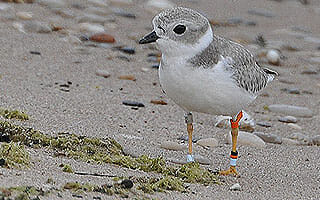 Piping plovers are tiny shorebirds that make shallow nests in the summer on flat, open, sandy beaches in northern Michigan – the same beaches that attract people, their pets and development. In 1986 there were only 17 nesting pairs of this endangered species remaining in the Great Lakes, and a federal recovery program was established by the United States Fish and Wildlife Service (USFWS). Scientists found that some of the plovers were abandoning their eggs, and they realized that salvaging these abandoned eggs could contribute significantly to the species’ recovery. Because of the Detroit Zoological Society’s (DZS) expertise in bird care and incubation, the DZS developed a captive rearing program to hatch out abandoned eggs and rear the tiny chicks until they can be released to join wild plovers. This “salvage rearing” is an important part of the federal recovery program for piping plovers.
Piping plovers are tiny shorebirds that make shallow nests in the summer on flat, open, sandy beaches in northern Michigan – the same beaches that attract people, their pets and development. In 1986 there were only 17 nesting pairs of this endangered species remaining in the Great Lakes, and a federal recovery program was established by the United States Fish and Wildlife Service (USFWS). Scientists found that some of the plovers were abandoning their eggs, and they realized that salvaging these abandoned eggs could contribute significantly to the species’ recovery. Because of the Detroit Zoological Society’s (DZS) expertise in bird care and incubation, the DZS developed a captive rearing program to hatch out abandoned eggs and rear the tiny chicks until they can be released to join wild plovers. This “salvage rearing” is an important part of the federal recovery program for piping plovers.
Abandoned eggs are brought to a captive rearing facility at the University of Michigan’s Biological Station in Pellston, Mich. The DZS oversees the incubation and rearing programs and coordinates the involvement of bird care staff from the Detroit Zoo and other Association of Zoos and Aquarium (AZA) institutions who help monitor the eggs and care for the chicks after they hatch. The chicks are reared in pens on the beach to protect them from predators as they acclimate to living in the wild. Piping plovers are able to fly by the time they’re four weeks old, and at that point they’re released at sites with adult plovers and their nearly grown chicks. They quickly acclimate into these groups and join them for the fall migration to the southern U.S., where they will spend the winter. The Great Lakes population of piping plovers is now about 80 breeding pairs, and the captive-reared birds and their descendants have made a significant contribution to this small population. The DZS piping plover program was recognized by the AZA with a Significant Achievement Award for North American Conservation in 2009. More information about the work being done by DZS and its collaborators can be found on the Great Lakes Piping Plover Recovery Effort website, Facebook, and Twitter.
Black Tern
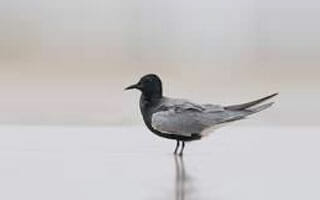 The black tern is considered a species of Special Concern by the Michigan Department of Natural Resources (MDNR). St. Clair Flats on Harsens Island is one of the most significant Important Bird Areas in Michigan, representing the world’s largest freshwater delta and hosting Michigan’s largest remaining black tern colony. Black terns have experienced drastic range-wide declines in recent decades, including in Michigan, but the cause of these declines is not well understood. Since 2012, the Detroit Zoological Society has assisted the Detroit Audubon, Great Lakes Audubon and the MDNR to study the nesting success of this species on St. Clair Flats in order to begin to understand whether conservation work is needed on their breeding colonies in Michigan or at the wintering grounds in the tropical seas west of Central and South America.
The black tern is considered a species of Special Concern by the Michigan Department of Natural Resources (MDNR). St. Clair Flats on Harsens Island is one of the most significant Important Bird Areas in Michigan, representing the world’s largest freshwater delta and hosting Michigan’s largest remaining black tern colony. Black terns have experienced drastic range-wide declines in recent decades, including in Michigan, but the cause of these declines is not well understood. Since 2012, the Detroit Zoological Society has assisted the Detroit Audubon, Great Lakes Audubon and the MDNR to study the nesting success of this species on St. Clair Flats in order to begin to understand whether conservation work is needed on their breeding colonies in Michigan or at the wintering grounds in the tropical seas west of Central and South America.
Osprey
 In the 1950s and 1960s, populations of osprey – fish-eating birds of prey – were decimated by the harmful effects of DDT pesticides on breeding success. The Detroit Zoological Society has worked with the volunteer organization Osprey Watch of Southeast Michigan, the MDNR and Huron Clinton Metropolitan Authority (HCMA) to help re-establish osprey to southeast Michigan. Osprey chicks from northern Michigan have been transferred to HCMA’s Kensington and Stony Creek Metroparks to establish osprey populations in these areas. Five-week-old male chicks from northern Michigan are taken from the nests in which they hatched to large enclosed boxes (called hacking towers). Males are chosen because they normally return to their fledging sites as adults to nest and rear offspring. Staff from the DZS supervise the rearing of chicks until they area ready to begin to fly. As they near this fledging stage, the box is opened and they quickly learn to fly and to catch fish.
In the 1950s and 1960s, populations of osprey – fish-eating birds of prey – were decimated by the harmful effects of DDT pesticides on breeding success. The Detroit Zoological Society has worked with the volunteer organization Osprey Watch of Southeast Michigan, the MDNR and Huron Clinton Metropolitan Authority (HCMA) to help re-establish osprey to southeast Michigan. Osprey chicks from northern Michigan have been transferred to HCMA’s Kensington and Stony Creek Metroparks to establish osprey populations in these areas. Five-week-old male chicks from northern Michigan are taken from the nests in which they hatched to large enclosed boxes (called hacking towers). Males are chosen because they normally return to their fledging sites as adults to nest and rear offspring. Staff from the DZS supervise the rearing of chicks until they area ready to begin to fly. As they near this fledging stage, the box is opened and they quickly learn to fly and to catch fish.
Since 2013, DZS has also helped with the banding of osprey chicks, conducting DNA testing to determine the sex of chicks and attaching satellite transmitters (18 since 2013) to track their movements. These transmitters have shown that the birds migrate from Michigan to South America via the Caribbean (learn more: http://michiganosprey.org). Male ospreys have returned from the southern migratory areas with new mates in tow and nesting sites have expanded outside SE Michigan so transplanting ospreys from other areas is no longer part of the project. The DZS now coordinates the monitoring of osprey nests in southern and central Michigan to determine hatching success.
Peregrine Falcon
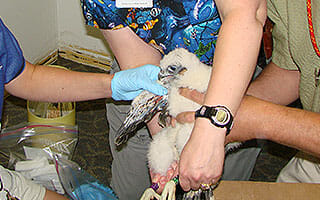
As with ospreys, peregrine falcon populations were decimated in the 1950s and 1960s by the harmful effects of DDT pesticides on breeding success. The last recorded peregrine nest in Michigan was in 1957. After DDT use was banned, peregrines were reintroduced to Michigan starting in the 1970s. This recovery has gone well especially in urban areas like Detroit where peregrines feed largely on pigeons that they can catch with high speed dives of up to 180 mph. The Detroit Zoological Society has worked with the Michigan Department of Natural Resources (MDNR) Natural Heritage Program for several years to band falcons in Detroit to help return this charismatic part of the city’s urban ecology as part of a wider effort to band nesting peregrines in urban areas in the eastern U.S. A pair of peregrine falcons took up residence in June 2016 on one of the most visible landmarks in the region, the Detroit Zoo water tower at Woodward Avenue and 10 Mile Road in Royal Oak. Zoo staff placed a specially designed nestbox in 2017 and different pairs of falcons have fledged chicks between 2017-2022.
Black-crowned Night Heron
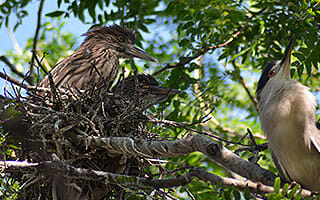 The Detroit Zoo is home to a large colony of wild black-crowned night herons that nest in various areas of the Zoo. DZS bird staff monitors the success of this colony and has begun a long-term population study where chicks are banded with colored bands so individual birds can be identified and monitored.
The Detroit Zoo is home to a large colony of wild black-crowned night herons that nest in various areas of the Zoo. DZS bird staff monitors the success of this colony and has begun a long-term population study where chicks are banded with colored bands so individual birds can be identified and monitored.
Trumpeter Swan
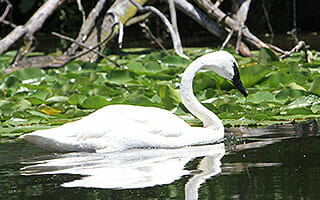 Trumpeter swans are endangered in the Great Lakes primarily because they are outcompeted by mute swans which were introduced from Europe and are less sensitive to human disturbance. The Detroit Zoological Society (DZS) worked with the Michigan Department of Natural Resources (MDNR) and Michigan State University’s Kellogg Biological Station from 1985 to 2006 to reintroduce trumpeter swans to northern Michigan. DZS raised 66 trumpeter swan cygnets at the Detroit Zoo and the former Belle Isle Zoo for release to sites in northern Michigan.
Trumpeter swans are endangered in the Great Lakes primarily because they are outcompeted by mute swans which were introduced from Europe and are less sensitive to human disturbance. The Detroit Zoological Society (DZS) worked with the Michigan Department of Natural Resources (MDNR) and Michigan State University’s Kellogg Biological Station from 1985 to 2006 to reintroduce trumpeter swans to northern Michigan. DZS raised 66 trumpeter swan cygnets at the Detroit Zoo and the former Belle Isle Zoo for release to sites in northern Michigan.
Falklands Conservation
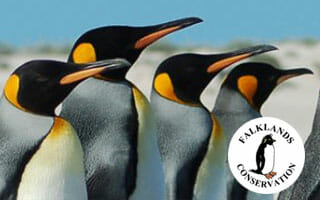 The Falkland Islands (Las Malvinas) off the southern coast of Argentina are a critical habitat for penguins and contain the largest breeding populations of gentoo and southern rockhopper penguins (about 100,000 and 200,000 breeding pairs, respectively). The Detroit Zoological Society (DZS) has funded the work of Falklands Conservation (FC), an organization which monitors and conducts research on the penguins and other wildlife at several island sites. This research helps to conserve penguin species at the Detroit Zoo’s Polk Penguin Conservation Center including king penguins, southern rockhopper penguins, gentoo penguins, and macaroni penguins. For example, some of the research uses satellite tracking and geo-locators to identify critical winter feeding areas for king penguins and southern rockhopper penguins. In 2016, 2017 and 2018, the DZS and FC collaborated on expeditions to several remote islands, using drones to more effectively conduct population surveys and document habitat conditions. In 2018, the collaboration expanded, and a long-term project was initiated to assess the health and welfare of gentoo and rockhopper penguins at two sites: one that is more remote and another that is more impacted by human activity such as oil extraction. The DZS and FC are hoping to clarify the potential impacts this human activity is having on the health and welfare of the penguins. These impacts may be different for the two penguin species because they have dissimilar ranging behavior: gentoos remain near the Falklands year round while rockhoppers migrate up to several hundred miles toward South America.
The Falkland Islands (Las Malvinas) off the southern coast of Argentina are a critical habitat for penguins and contain the largest breeding populations of gentoo and southern rockhopper penguins (about 100,000 and 200,000 breeding pairs, respectively). The Detroit Zoological Society (DZS) has funded the work of Falklands Conservation (FC), an organization which monitors and conducts research on the penguins and other wildlife at several island sites. This research helps to conserve penguin species at the Detroit Zoo’s Polk Penguin Conservation Center including king penguins, southern rockhopper penguins, gentoo penguins, and macaroni penguins. For example, some of the research uses satellite tracking and geo-locators to identify critical winter feeding areas for king penguins and southern rockhopper penguins. In 2016, 2017 and 2018, the DZS and FC collaborated on expeditions to several remote islands, using drones to more effectively conduct population surveys and document habitat conditions. In 2018, the collaboration expanded, and a long-term project was initiated to assess the health and welfare of gentoo and rockhopper penguins at two sites: one that is more remote and another that is more impacted by human activity such as oil extraction. The DZS and FC are hoping to clarify the potential impacts this human activity is having on the health and welfare of the penguins. These impacts may be different for the two penguin species because they have dissimilar ranging behavior: gentoos remain near the Falklands year round while rockhoppers migrate up to several hundred miles toward South America.
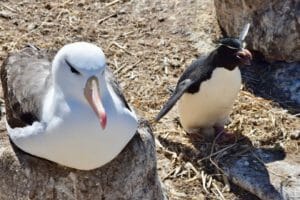
Black-browed albatross and southern rockhopper penguin

Drone’s-eye view of colonies with southern rockhopper penguins and black-browed albatross
Center for Ecosystem Sentinels
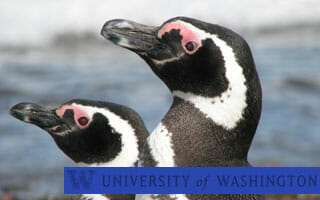 The Detroit Zoological Society provides funds to support the Center for Ecosystem Sentinels research on Magellanic penguins in Argentina and Galapagos penguins of the Galapagos Islands off the coast of Ecuador. These temperate penguin species – marine sentinels for southern oceans – demonstrate that new challenges are confronting their populations. For example, The Center for Penguins as Ocean Sentinels has demonstrated that Magellanic penguins are swimming 36 miles farther north from their nests during incubation than they did a decade ago. This very likely reflects shifts in prey in response to climate change and reductions in prey abundance caused by commercial fishing. The Center has also shown that increased rain has adversely affected the breeding success of Magellenic penguins. Furthermore, the Center has documented that the Galapagos penguin population has declined by about 75% since 1972 because of variations in the surface temperatures of the eastern Pacific Ocean that are increasing in strength and frequency. The warm temperature cycles are known as El Niños and they are particularly difficult for Galapagos penguins. The current Galapagos penguin population may be as low as 1,500 individuals making them the rarest of all penguin species.
The Detroit Zoological Society provides funds to support the Center for Ecosystem Sentinels research on Magellanic penguins in Argentina and Galapagos penguins of the Galapagos Islands off the coast of Ecuador. These temperate penguin species – marine sentinels for southern oceans – demonstrate that new challenges are confronting their populations. For example, The Center for Penguins as Ocean Sentinels has demonstrated that Magellanic penguins are swimming 36 miles farther north from their nests during incubation than they did a decade ago. This very likely reflects shifts in prey in response to climate change and reductions in prey abundance caused by commercial fishing. The Center has also shown that increased rain has adversely affected the breeding success of Magellenic penguins. Furthermore, the Center has documented that the Galapagos penguin population has declined by about 75% since 1972 because of variations in the surface temperatures of the eastern Pacific Ocean that are increasing in strength and frequency. The warm temperature cycles are known as El Niños and they are particularly difficult for Galapagos penguins. The current Galapagos penguin population may be as low as 1,500 individuals making them the rarest of all penguin species.
Bird Collisions
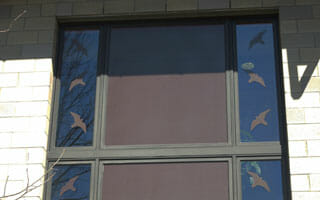 A bird collision is a phenomenon that occurs when a wild bird flies into a window and stuns themselves, many of the collision victims die.. The glass appears invisible to the bird, as it has a different visual system than a human. An estimated 253 million birds in the U.S. are killed from these collisions each year, according to the American Bird Conservancy.
A bird collision is a phenomenon that occurs when a wild bird flies into a window and stuns themselves, many of the collision victims die.. The glass appears invisible to the bird, as it has a different visual system than a human. An estimated 253 million birds in the U.S. are killed from these collisions each year, according to the American Bird Conservancy.
 The DZS has taken preventative measures to improve the welfare of songbirds and prevent window collisions by applying window film and window dots to areas being tracked for collisions. DZS has also installed bird-safe glass in many areas of the Zoo. Members of the community can do their part to prevent bird collisions by turning off lights at night in tall buildings and putting up bird silhouettes, reflective tape or special film on windows to reduce the outside reflection, allowing birds to see the window as a barrier.
The DZS has taken preventative measures to improve the welfare of songbirds and prevent window collisions by applying window film and window dots to areas being tracked for collisions. DZS has also installed bird-safe glass in many areas of the Zoo. Members of the community can do their part to prevent bird collisions by turning off lights at night in tall buildings and putting up bird silhouettes, reflective tape or special film on windows to reduce the outside reflection, allowing birds to see the window as a barrier.
State of the World’s Birds Report
One in eight bird species is in danger of extinction. Learn about the current state of birds in nature and what is being done to protect wild bird populations in the 2022 State of the Birds World’s Birds Report.





